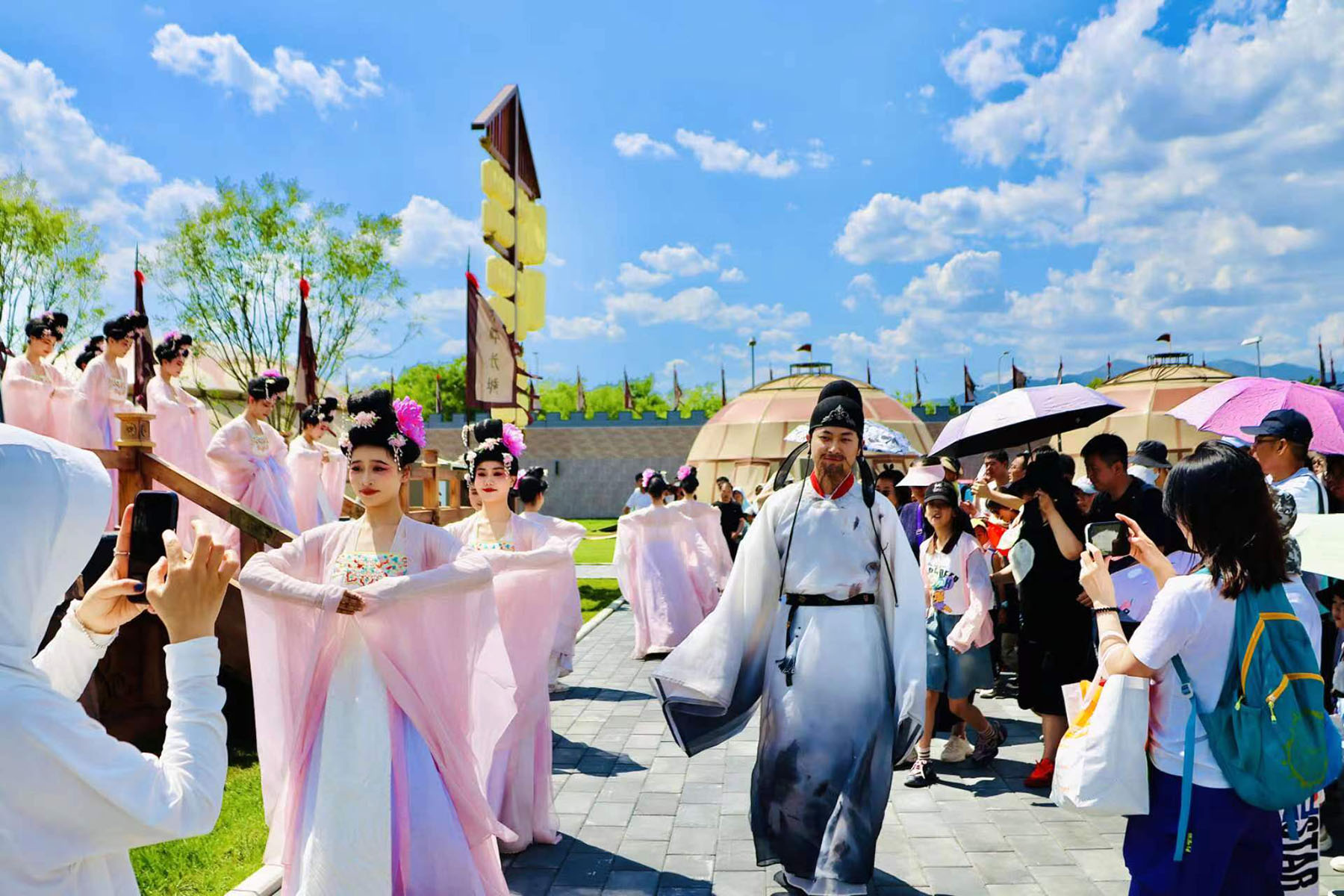Badaling section of the historic structure gives tourists a taste of the past with modern comforts, Yang Feiyue reports.

Short but intense storms have sprung upon the capital city since early June, often with little warning. Yet, as swiftly as they come, they retreat, leaving in their wake a stunning sunset and crystal clear blue sky.
This cleansing effect seems magical when one drives to Yanqing, the outer suburban district northwest of Beijing.
Badaling Great Wall is one of the district's popular areas that take people's mind off from the bustling city center. It rests on the mountain ridges and seems to have its features — the thick curves of yellow bricks and rugged edges — brought into sharp relief. The clarity somehow magnifies its size and makes it look very close to viewers from the meandering mountainside highway.
About a 20-minute drive northward from the first sight of the Badaling section, camp tents, watchtower-like walls and an enclosed horse racetrack emerge at Beijing Expo Park. Men and women dressed in ancient-looking warrior costumes pulling stunts on the back of racehorses are visible upon walking into the facility carrying the Great Wall elements. The crack of their whip and the sheen of horse manes under the sun bring people back in time.
READ MORE: Great Wall restoration teams uncover trove of secrets
It is part of an immersive experience that local authorities have developed to bring visitors closer to the history and culture of the Great Wall.
The arrangement of such prelude eases tourists into the grand drama, Dream of the Great Wall, further into the facility, where various periods of major Great Wall development, from the Qin (221-206 BC) to the Han (206 BC-AD 220) and the Tang (618-907) and Ming (1368-1644) dynasties, are delivered onstage and walk the audience down history lane.
The 50-minute drama premiered in early June and has strung together stories of historical figures and anecdotes related to the Great Wall.

It exposes the audience to the initial severe hardships facing the Wall laborers, the formidable determination of the Qin Dynasty to unify the nation, and the faith and pride of the Han Dynasty in fortifying and expanding the Great Wall to consolidate its power, as well as the ensuing prosperity of the Tang Dynasty.
Visitors can get a big picture of how the Great Wall evolved into a world wonder and experience the whole gamut of historical figures' sentiments through the stage presentation that integrates music, dance, acrobatics and folk customs.
Interactive sessions have also been prepared for travelers to experience the hardships of constructing the Great Wall or engage in a poetry exchange session with an actor playing the role of Li Bai, a Tang Dynasty poet.
"We started to build the stage in December last year, reutilizing vacant land in the park," says Yue Junfang, a staff member with Xiadu Cultural Communications, which is in charge of the drama operations.
Approximately 180 crew members have engaged in regular performances, and the facility has received more than 600 visitors per day.
Yue expects the number to keep growing as summer vacation continues. More sessions will be offered daily.
"We have special buses that can take visitors from downtown all the way here," Yue says.
The drama is among local authorities' latest efforts to foster a deeper appreciation for the Great Wall, which President Xi Jinping in May called for continued efforts to protect. In his reply to a letter recounting Great Wall protection work from residents in Shixia village at the foot of the Badaling Great Wall, Xi made remarks about promoting its culture and passing on its precious heritage to future generations.

In addition to the new show, night tours of the Badaling Great Wall have been launched since May.
The performance programs have been innovatively redesigned and a "processional viewing" mode has been introduced to immerse visitors in different historical scenes, according to Zhai Yanwei, deputy general manager of Badaling Culture and Tourism Group.
Tree-shaped lighting systems, interactive non-player characters, daring motorbike stunts and a range of Great Wall-themed cultural and creative souvenirs dot the whole journey, which has proved a hit among visitors, Zhai says.
Since it was first launched a few years ago, night tours of the Badaling Great Wall have packed in more than 400,000 visits, including 250,000 last year, according to Badaling Culture and Tourism Group.
"We will receive more visits this year," Zhai says.
Night tour visitors have spent five times as much as they did before and are more likely to stay the night in Yanqing, which has prompted them to explore more of what the district has to offer, she observes.
"Many travelers have chosen to stay at the star-rated hotels or homestays in Yanqing after the night tour and contributed to the bookings of 20,000 to 30,000 rooms last year," Zhai says.
To spice up the tourist experience, Yanqing has also rolled out leisure tours lasting from two to three days.
At the center of the arrangement is a night boating experience on the Guishui River, which originates from the district and runs 18.5 kilometers from east to west.
The river is transformed into a realm of mystery and serenity under the embrace of the night sky, with the gently swaying reeds, heart-shaped islands and an illuminated pagoda, dotting the surroundings and casting enchanting reflections.

Several performances are put in place during the boat trip, highlighting stories about local people and the legendary ruler Shun of over 4,000 years ago, who is regarded as one of the ancestors of the Chinese nation.
The actresses dressed in traditional Chinese costumes dancing on a floating canoe are eye-catching.
Additionally, there is a sightseeing bus tour that covers local wetland parks and wild duck habitats.
The tourist activities are aimed to satisfy their rising needs and complement their experiences centering on the Badaling Great Wall.
"We have received positive feedback from tourists," Zhai says.
ALSO READ: Inbound tourism drive sparks optimistic outlook
In particular, with China's increasingly favorable inbound tourism policies, such as visa-free entry, the Badaling area's charm has been enhanced among international travelers, taking in 147,000 tourists from abroad as of mid-June this year, up 81 percent over the same period of 2023, Badaling Culture and Tourism Group reports.
Rong Xinfeng, Party secretary of the group, recently announced eight measures to facilitate inbound tourist visits, including multilingual services, optimized transportation, convenient payment options, unique dining experiences, comfortable accommodations, and cultural and creative gifts, with the goal of giving inbound tourists a seamless travel experience in Yanqing, according to Rong.
Inbound tourists can use their passports or permanent residence permits to buy tickets at manned windows on the scenic spot or via the WeChat mini-program, Travel Inside and Outside the Great Wall.
Bookings of major Great Wall experiences, including the night tour and cable car, can be made on the online travel agency Trip.com Group's operations in 14 overseas sites, Zhai says.
"It will expand to 38 countries in July, mostly in Asia, Europe and the United States, and more countries and regions will be covered in the future," she adds.
Contact the writer at yangfeiyue@chinadaily.com.cn


